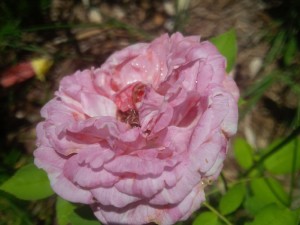After four years of waiting, at least one go-around with Mr. Antlers and a presumption of plant death, ‘Vick’s Caprice’ has finally bloomed in my garden. And even though the tough little rose put out only one flower, it was worth the time and anxiety. The cupped and quartered bloom is lovely–rose pink, accented with barely discernible stripes of lighter pink. I took its picture immediately, just to capture the moment when patience paid off.
‘Vick’s Caprice’ is classified as an “old rose” because it came on the scene between 1800 and 1920. Unlike many famous old varieties, it is an American original. Discovered around 1885 in Rochester, NY, ‘Vick’s Caprice’ is classed as a hybrid perpetual, a type of reblooming rose that was very popular just before the introduction of the first of the showy hybrid teas that dominated twentieth century gardens.
If ‘Vick’s Caprice’ came on the scene today, it would probably have its own reality show. The name “Vick” comes from nursery owner James Vick, who found the chance seedling in his western New York garden. The “caprice” part was added as the result of a deliberate name suggestion solicitation by the publicity-conscious Vick. Announcing the results in his self-published garden magazine, Vick wrote, “Among the many thousands of names that have been sent in by our friends for our new striped rose, the name ‘Vick’s Caprice’ has been selected.”
‘Caprice’s parent was a French rose, ‘Archiduchesse Elizabeth d’Autriche’, another hybrid perpetual, with blooms that are darker pink than those of its offspring. Both roses bear large flowers with many petals, and stems with very few thorns. These traits, coupled with a repeat blooming habit, make hybrid perpetual roses easy to love. ‘Vick’s Caprice’ is also
fragrant, though its scent is not overwhelming. Topping out at three to four feet tall, it could easily be grown in-ground or in a large pot.
Like other plant breeders, rose hybridizers always aim to maximize desirable traits, such as large flowers, while minimizing less desirable ones, like weak stems. Achieving the best traits generally involves cross breeding successive generations of roses, sometimes using more than one rose species or type. In the case of the hybrid perpetuals, breeders crossed three different old rose types: hybrid China, Portland and Bourbon roses. Bourbons, like the still-available ‘Zepherine Drouhin’, are remontant or repeat-flowering in most cases, and bear few thorns. They also tend to be fragrant. Portlands feature large flowers, plus a repeat-blooming and vigorous growth habit. Hybrid Chinas are once bloomers, but known for their vigorous habits.
‘Vick’s Caprice’ was not the result of such deliberate breeding efforts, but popped up in James Vick’s garden, probably the result of seed dropped by a nearby ‘Archiduchesse Elizabeth d’Autriche’ shrub. Vick allowed the seedling to grow to flowering size and was taken with the pink-striped blooms. He propagated the plant by means of cuttings, which was the only means of commercial propagation until the end of the twentieth century when tissue culture came on the horticultural scene. When he had enough plants to sell, he invited his readers to send in possible names.
This kind of interactive outreach was characteristic of the British-born Vick, who was born in 1818 and originally trained as a typesetter and printer. Becoming a writer, editor, publisher and owner of horticultural publications, Vick pursued a love of gardening to the point that in 1860 he started his own seed company in his adopted hometown of Rochester. Selling seeds by mail order, supported by the effusive prose and colorful illustrations of his “Floral Guide and Catalog,” Vick succeeded spectacularly. Only two years later, in 1862, Vick’s firm boasted about 150 employees and is said to have received some three thousand letters per day. The latter figure seems hyperbolic to me, but then, Vick did say that “thousands” of names were suggested for the rose that became ‘Vick’s Caprice’.
Vick died in 1882 and was survived by his sons, who ran his monthly magazine and the seed company until the company was sold to the Burpee Seed Company early in the twentieth century. He is still survived by ‘Vick’s Caprice’, which is available from old rose vendors like Rogue Valley Roses; 2368 Terri Drive Medford, OR 97504; (541) 535-1307; www.roguevalleyroses.com.
To celebrate the first ‘Vick’s Caprice’ flower, I have watered the pant thoroughly, fed it with worm castings, mulched around it and sprayed it with deer repellent. Its first flower was mostly the result of benign neglect. I hope that I have not just killed the plant with kindness.

